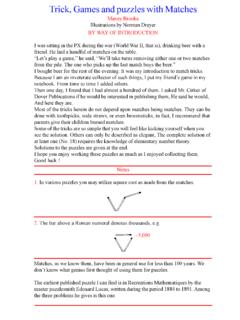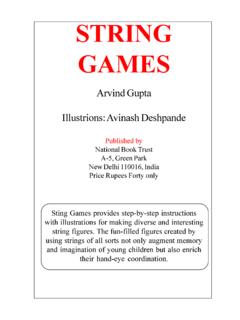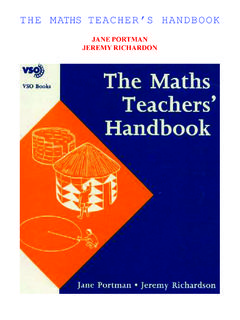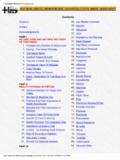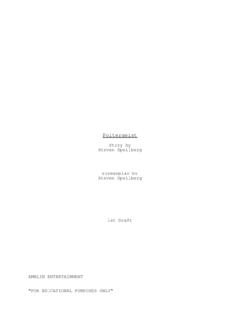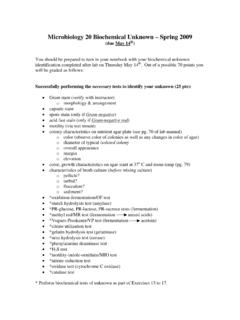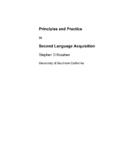Transcription of SCIENCE EXPERIMENTS WITH PAPER Steven W. Moje
1 SCIENCE EXPERIMENTS WITH PAPERS teven W. MojeAmaze your eyesFrom PAPER bags to cardboard boxes, from crinkly crepe to thin tissue pick any kind of PAPER and writeyour ticket to SCIENCE fun! Just add some easy-to-find materials like ping-pong balls and combs, and create aweather vane to [earn about air, a PAPER bridge and birds to demonstrate balance, and a spinning spiral snaketo show the power of heat..Go up, up, and away with index-card helicopters. Make a bang with a PAPER popper. Cause static cling witha tissue- PAPER doll. Other EXPERIMENTS work with chemistry, light, motion, math, and water. It s the perfectcombination of SCIENCE and play 100 times over!PREFACEP aper is one of the simplest, versatile, available and least expensive materials known to humankind. Although mostcommonly used for writing, packaging, and wrapping, it is also perfect for doing SCIENCE EXPERIMENTS .]
2 Humans haveused PAPER or PAPER -like substances for thousands of years. The word PAPER comes from the word papyrus, a plantfrom which the ancient Egyptians produced a material like PAPER to write upon. Nowadays, wood pulp from trees is theusual source of PAPER fibers. To make PAPER , these fibers are mixed with a large amount of water. Small amounts ofadditives such as glue and clay are mixed in, and water is removed through wire screens. The PAPER fibers deposited onthe screens are dried, smoothed, and cut to give many types, thicknesses, and sizes of this book, you will learn how to do 100 exciting SCIENCE EXPERIMENTS with PAPER . EXPERIMENTS are organized intothese categories: air, balancing, chemistry, electricity and magnetism, flying things, heat, light, motion and inertia, noise-and sound-makers, topology, water, and other book is easy enough for children to do, but can be enjoyed by other people as well.
3 The EXPERIMENTS in 100 Simple SCIENCE EXPERIMENTS with PAPER are fun, easy, and safe to do, and can be performed using materials andequipment commonly found around the house. Teachers, parents, and children alike will delight in discovering the manyways in which PAPER can be used to learn and enjoy SCIENCE at home and in the OF PAPERT here are many different sizes and weights of PAPER . PAPER size ranges from small, 3x5 inch ( x 13 cm) scratchpads to medium, x 11 inch (22 x 28 cm) school notebook PAPER , to large construction PAPER , artist s PAPER , andnewsprint. You will find these and many other sizes and kinds of PAPER at your local grocery, variety, arts & crafts, orhobby supply weight ranges from light to heavy. The heavier and thicker the PAPER , the stronger it is. Lightweight PAPER (such as onionskin or erasable typewriter PAPER ) is good for activities where light weight is important, such as makingairplanes or kites.
4 Medium-weight PAPER (which includes notebook PAPER , scratch pads, and computer printer PAPER )is fairly strong and not too heavy. It can be used for most of the EXPERIMENTS in this book. Heavy-weight PAPER (forexample, index cards or cardboard) is good for construction activities where strength and stability are important, suchas building PAPER towers, and for balancing types of PAPER used in this book are: Brown lunch and grocery bags Cardboard (packing boxes, cereal boxes, etc.) Cardboard oatmeal cartons (cylinder-shaped) These are standard sizes in the US. PAPER sizes in other countries are slightly different in size. Use the closest sizeif these aren t available to you. Cardboard tubes from toilet PAPER or PAPER towels Computer printer PAPER Coffee filters Construction and drawing PAPER Crepe PAPER Dollar bill (or other PAPER money) Index cards (small and large sizes) Manila file folders Newspaper Notebook PAPER Note pads Onionskin PAPER PAPER cups PAPER plates PAPER towels Tissue PAPER Toilet PAPER Waxed PAPER Writing paperOTHER MATERIALSM aterials (in addition to PAPER ) used for EXPERIMENTS in this book are.
5 Bowl Bugs (crawling and flying) Buttons Cartons from orange juice of milk Coat hanger Coins (pennies, nickels, quarters or other coins) Comb for hair Cornstarch Dishwashing liquid Drinking straws (for soda, flexible and straight) Food coloring Fruit (soft fruit such as grape and banana) Glue (school glue) Ice cream or craft sticks Lemon and orange juice Metal washer, bolt, nut, and nail Paintbrush PAPER clips (jumbo and standard sizes) Ping-pong ball Pipe cleaners Plastic soda bottle Plastic wrap Plates (plastic, polystyrene foam, and aluminum) Rocks Rectangular pencil eraser Rubber bands Sand, salt, sugar, rice, or other small-grained materials Seeds Soap Spool of thread String Thumbtack or pin Toothpicks Water and ice WoolTOOLS AND EQUIPMENTT ools and equipment used for EXPERIMENTS in this book are: Ballpoint pen Books Drawing compass Lamp Magnet (store-bought for experiment, or else use a refrigerator or shower-curtain magnet) Markers (water-based and permanent) Pencil Plastic dishpan Plastic funnel Plastic or glass drinking glass Ruler (or yardstick or meter stick) Scissors Tape (clear cellophane tape, masking tape, and duct tape) Toaster Wide-mouth jar with lidPAPER FANYou will need:Notebook PAPER , tapeWhat to do:Fold a sheet of notebook PAPER into an accordion shape.
6 Pinch together the folds, 1 to 2 inches (3 to 5 cm) fromone of the ends. Tape the folded end to make a handle. Grasp the handle and wave your hand back and forth. You willfeel a cooling breeze on your face!How it works:Even though you cannot see air, it is just as real as objects that are visible. Air has mass and takes up space, just likevisible objects. When the PAPER fan moves the air, you feel the motion of the air as a breeze on your SCIENCE fun:Make fans out of larger and smaller PAPER . Which size gives the strongest breeze? Is there a limit to the size (smallestor largest) of the fan that you can make? PAPER PLATE FANYou will need: PAPER plate, ice cream (craft) stick, tapeWhat to do:Tape an ice cream stick to the back of a PAPER plate. Grasp the stick and wave the plate back and forth. You will feela cooling breeze on your face!How it works:Just as with a PAPER fan, the PAPER plate fan pushes air when you move the fan handle.
7 As the large round surface ofthe PAPER plate fan pushes the air, you feel it as a breeze on your SCIENCE fun:Which fan ( PAPER or PAPER plate) gives a stronger breeze? Make fans from larger and smaller PAPER plates. Whichsize gives the strongest breeze? Is there a limit to the size of the fan that you can make? Make fans from other types ofplates (plastic or polystyrene foam). PAPER SHEET AND PAPER BALL RACEYou will need:Notebook paperWhat to do:Crumple a piece of notebook PAPER into a ball. Drop it at the same time as you drop a flat sheet of notebook piece of PAPER takes longer to fall than the ball of it works:There is more air pressing on the surface of the flat piece of PAPER than on the surface of the PAPER ball. Thecrumpled up ball has less air to push out of the way as it falls than the flat piece of PAPER does. That is why the ball hitsthe ground SCIENCE fun:Do the experiment with different sizes and shapes of PAPER sheets and PAPER balls.
8 Which sizes and shapes fallsfastest? Which falls slowest?INDEX CARD FALLYou will need:Index cardsWhat to do:Hold up two index cards, one on edge and the otherflat. Drop them both at the same time. The index cardwhich is on edge will reach the ground first After a shortdistance, the on-edge index card will behave as theother (flat) index card does, dropping with a randomfloppy motion which alternates from horizontal it works:As with the flat vs. balled-up piece of PAPER , the object that has a greater surface area exposed to the air falls SCIENCE fun:Use different sizes of index cards. Which size falls fastest? Bend an index card. Does it fall faster or slower than anunbent card? PAPER ON FALLING BOOK OR COIN RACEYou will need: PAPER , book, coinWhat to do:Place a piece of PAPER on top of a book; make sure that the PAPER is smaller than the book.
9 Drop both together. Thepaper will stick to the top of the book. Now drop a piece of PAPER by itself. It falls much more slowly. Do a similarexperiment with a smaller piece of PAPER placed on top of a large coin (instead of on a book).How it works:The book and coin push aside the air in front of the PAPER . For this reason, the PAPER falls at the same (fast) rate asits heavier helper (the book or coin). A piece of PAPER falling by itself cannot as easily overcome air , it falls more SCIENCE fun:Drop different sizes of PAPER on different weights of books and coins. Which combinations of sizes and weights fallsfastest?AIRFOILYou will need:Notebook PAPER , straw, tapeWhat to do:Bend a piece of notebook PAPER in half. Place a straw inside the PAPER , along the bend. Allow 1 inch ( cm) ofthe straw to stick out of the PAPER . Tape the loose ends of the PAPER together to make an wing-like shape or along the top of the airfoil.
10 The PAPER will lift into the air!How it works:Moving air has less pressure than still air. The faster that air moves, the less air pressure it has. Air passing over thecurved top of the airfoil has to travel further (and thus faster) than air on the flat bottom of the airfoil. Since the airpassing over the bottom of the airfoil has more pressure than air passing over the top, the airfoil is pushed SCIENCE fun:Blow harder on the airfoil. Does the airfoil rise more quickly? Make a larger airfoil, using a large brown grocerybag and wooden dowel. Your breath will probably not be strong enough to cause the airfoil to rise. To create astronger wind, use a hair dryer or the blower end of a vacuum cleaner. Which works better? PAPER STRIP AIR LIFTYou will need:2x5 inch (5 x 13 cm) strip of notebook paperWhat to do:Hold a 2 x 5 inch strip of PAPER between your thumb and forefinger.




